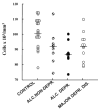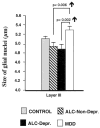Comparison of prefrontal cell pathology between depression and alcohol dependence
- PMID: 12849933
- PMCID: PMC3118500
- DOI: 10.1016/s0022-3956(03)00049-9
Comparison of prefrontal cell pathology between depression and alcohol dependence
Abstract
Chronic alcohol abuse is often co-morbid with depression symptoms and in many cases it appears to induce major depressive disorder. Structural and functional neuroimaging has provided evidence supporting some degree of neuropathological convergence of alcoholism and mood disorders. In order to understand the cellular neuropathology of alcohol dependence and mood disorders, postmortem morphometric studies have tested the possibility of alterations in the number and size of cells in the prefrontal cortex and other brain regions. The present review compares the cell pathology in the prefrontal cortex between alcohol dependence and depression, and reveals both similarities and differences. One of the most striking similarities is that, although pathology affects both neuronal and glial cells, effects on glia are more dramatic than on neurons in both alcohol dependence comorbid with depression and idiopathic depression. Moreover, prefrontal cortical regions are commonly affected in both depression and alcoholism. However, the cellular changes are more prominent and spread across cortical layers in alcohol dependent subjects than in subjects with mood disorders, and changes in glial nucleus size are opposite in alcoholism and depression. It could be argued that one defining factor in the manifestation of the depressive pathology is a reduction in the glial distribution in the dlPFC that is reflected in a reduced glial density. In alcoholism reduced glial nuclear size might be related to the cytotoxic effects of prolonged alcohol exposure, while in MDD, in the absence of alcohol abuse, other processes might be responsible for the increase in average size of glial nuclei. In either case abnormal function related to glial reduction would be associated with depression due to insufficient glial support to the surrounding neurons.
Figures



Similar articles
-
Glia pathology in the prefrontal cortex in alcohol dependence with and without depressive symptoms.Biol Psychiatry. 2002 Dec 15;52(12):1121-33. doi: 10.1016/s0006-3223(02)01439-7. Biol Psychiatry. 2002. PMID: 12488057 Free PMC article.
-
Morphometric evidence for neuronal and glial prefrontal cell pathology in major depression.Biol Psychiatry. 1999 May 1;45(9):1085-98. doi: 10.1016/s0006-3223(99)00041-4. Biol Psychiatry. 1999. PMID: 10331101
-
Alcohol dependence-related increase of glial cell density in the anterior cingulate cortex of suicide completers.J Psychiatry Neurosci. 2009 Jul;34(4):281-8. J Psychiatry Neurosci. 2009. PMID: 19568479 Free PMC article.
-
Glial pathology in neuropsychiatric disorders: a brief review.J Basic Clin Physiol Pharmacol. 2019 Jul 8;30(4). doi: 10.1515/jbcpp-2018-0120. J Basic Clin Physiol Pharmacol. 2019. PMID: 31280243 Review.
-
Gliogenesis and glial pathology in depression.CNS Neurol Disord Drug Targets. 2007 Jun;6(3):219-33. doi: 10.2174/187152707780619326. CNS Neurol Disord Drug Targets. 2007. PMID: 17511618 Free PMC article. Review.
Cited by
-
Astrocytes and Alcohol Throughout the Lifespan.Biol Psychiatry. 2025 Apr 30:S0006-3223(25)01147-3. doi: 10.1016/j.biopsych.2025.04.013. Online ahead of print. Biol Psychiatry. 2025. PMID: 40311830 Free PMC article. Review.
-
Neuroglia in Psychiatric Disorders.Adv Neurobiol. 2021;26:3-19. doi: 10.1007/978-3-030-77375-5_1. Adv Neurobiol. 2021. PMID: 34888828 Free PMC article.
-
Astroglia in the Vulnerability and Maintenance of Alcohol Use Disorders.Adv Neurobiol. 2021;26:255-279. doi: 10.1007/978-3-030-77375-5_11. Adv Neurobiol. 2021. PMID: 34888838
-
Markers of apoptosis induction and proliferation in the orbitofrontal cortex in alcohol dependence.Alcohol Clin Exp Res. 2014 Nov;38(11):2790-9. doi: 10.1111/acer.12559. Alcohol Clin Exp Res. 2014. PMID: 25421516 Free PMC article.
-
Alcohol induced depressive-like behavior is associated with a reduction in hippocampal BDNF.Pharmacol Biochem Behav. 2011 Dec;100(2):253-8. doi: 10.1016/j.pbb.2011.08.014. Epub 2011 Sep 10. Pharmacol Biochem Behav. 2011. PMID: 21930150 Free PMC article.
References
-
- Adams KM, Gilman S, Koeppe B, Kluin K, Junck L, Lohman M, et al. Correlation of neuropsychological function with cerebral metabolic rate in subdivisions of the frontal cortex of older alcoholics patients measured with [18F]fluorodeoxyglucose and positron emision tomography. Neuropsychology. 1995;9:275–80.
-
- Adams KM, Gilman S, Koeppe RA, Kluin KJ, Brunberg JA, Dede D, et al. Neuropsychological deficits are correlated with frontal hypometabolism in positron emission tomography studies of older alcoholic patients. Alcohol Clinical and Experimental Research. 1993;17:205–10. - PubMed
-
- Agartz I, Momenan R, Rawlings RR, Kerich MJ, Hommer DW. Hippocampal volume in patients with alcohol dependence. Archives of General Psychiatry. 1999;56:356–63. - PubMed
-
- Altshuler LL, Conrad A, Hauser P, Li XM, Guze BH, et al. Reduction of temporal lobe volume in bipolar disorder: a preliminary report of magnetic resonance imaging. Archives of General Psychiatry. 1991;48:482–3. - PubMed
-
- Arikuni T, Watanabe K, Kubota K. Connections of area 8 with area 6 in the brain of the macaque monkey. The Journal of Comparative Neurology. 1988;277:21–40. - PubMed
Publication types
MeSH terms
Grants and funding
LinkOut - more resources
Full Text Sources
Medical

